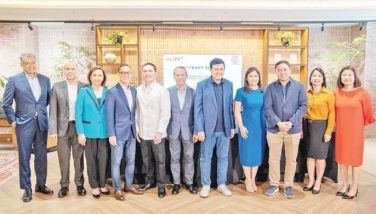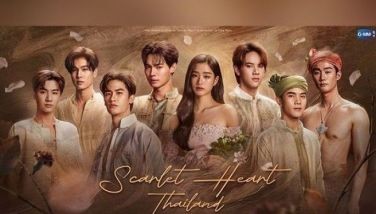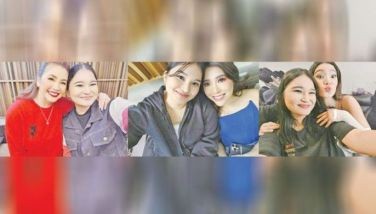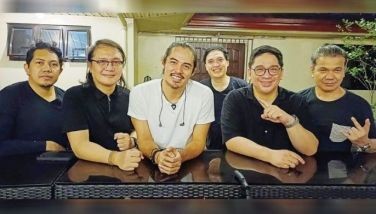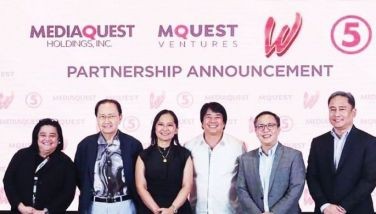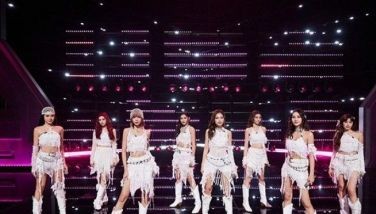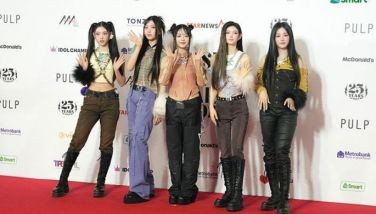The Beatles' last gig
MANILA, Philippines - Was the 30-minute concert in Candlestick Park, San Francisco on Aug. 29, 1966 the last ever by The Beatles? Think again. How about the concert the group gave on Jan. 29, 1969 at the Apple rooftops in Savile Row that was captured in the film Let It Be? The answer to both is “yes.” The first was to a paying audience, the second — hardly considered a concert — was for free.
Marking its 40th anniversary last month, the free concert given by The Beatles became a fitting end to the group’s remarkable career. Conceived four days before the actual event, the idea was thrown for consideration during a meeting by film director Michael Lindsay-Hogg. Despite their reluctance, George Harrison and Ringo Starr were prevailed upon by John Lennon and Paul McCartney to do this live gig for filming. Billy Preston, a friend from the early days, joined the group on keyboards.
The Let It Be album, which began with a tentative title Get Back, was an attempt by the group to produce an honest album, meaning free of overdubs, editing — an equivalent to recording the album live. John Lennon told George Martin, The Beatles’ producer, pointblank, “I don’t want any editing. I don’t want any over-dubbing. It’s got be like it is. We just record the song and that’s it.”
The group simply got tired of the lush production put in Sgt. Pepper’s Lonely Hearts Club Band, the very reason they followed it up with a self-titled double album more popularly known as The White Album, which many critics considered back-to-basics. Even its cover, which was bare white, was comparatively different from the lavishly colorful Sgt. Pepper’s cover. Yet probably the band was still not content.
George Harrison, on hindsight, adds, “I think the original idea was Paul’s — to rehearse some new songs, pick a location and record the album of the songs in a concert. We would learn the tunes and record them without loads of overdubs: Do a live album.” This would have been another first for the group had this materialized — a live recording of all-new songs.
But beginning a month-long work on the album originally dubbed Get Back Sessions, The Beatles were not on best terms with each other. The relationship between George and John and then between George and Paul was strained. Towards mid-January, George walked out of the session and stayed out for several days; and when he returned, he brought with him Billy Preston, a keyboardist par excellence that the group met way back in Hamburg. Preston replayed the role of Eric Clapton when the latter was invited, also by George, to do the lead guitar section in While My Guitar Gently Weeps for the White Album in mid-1968. Tension between The Beatles was already showing at that time as evidenced by Ringo taking a leave from the sessions only to be wooed back with cards, flowers plus assurances from the other three. Eric’s presence put a temporary halt to the group bitching with each other. Working on their next project, Let It Be, only a few months after the release of the double album, the boys saw their relationship with each other deteriorate in no time. This time, bringing Preston to the studio, in George’s mind, could improve the studio working atmosphere.
This idea of an honest album was accompanied by another: To film The Beatles at work for a promotional TV documentary when the album was released. Also conceived was a 30-minute the-making-of-the-TV-documentary film, according to Bill Harry, author of several books on The Beatles. All this required installing a film crew in the studio that captured everything that happened since The Beatles started working on the album from the second of January. The culmination, as designed, was to be a live performance of the new repertoire. Initial venue for the show, which was eventually junked for financial reasons, was the Roundhouse in London. Film director Lindsay-Hogg, who had The Beatles’ promotional video Paperback Writer and the Rolling Stones’ film Rock N’ Roll Circus in his resume, then came up with the idea of the Roman ampitheater in Tripoli to George’s vehement objection, anticipating the logistical nightmare this would entail. With time running out, they settled for the rooftop of the Apple Corporation.
Author Bob Spitz records the unanimous opinion: What a great idea it would be to play on the roof — play to the whole West End. According to him, the idea attracted The Beatles because they instantly give a concert minus the hassles of promotion, ticket sales, security, fans, press and other attendant issues. Besides, he quotes George as saying, “Nobody had ever done that so it would be interesting to see what happened when we started playing up there.”
Jan. 30 was a day to remember for Beatles fans all over the world. As early as late 2008, events to commemorate the 40th anniversary of this historic performance were already lined up. Ken Mansfield, US Apple Records manager, would share his story this late January along with The Beatles tribute band Crème Tangerine. BBC Radio 2 produced I Hope We Passed the Audition, a radio program, for the 27th of January to commemorate this event, including accounts from no less than Yoko Ono, Michael Lindsay-Hogg, Alan Parsons and one of those policemen present that ordered the group to stop the performance.
Early that day, a makeshift stage was put up on the roof on which the ever-reliable Mal Evans and Neil Aspinall, the two closest associates of The Beatles since the early days, set up the instruments for this one final gig together by the band. Aspinall, who succumbed to cancer last year, headed the Apple Corp. for 40 years and guarded practically the group’s legacy rather very conservatively as observed by many fans who were hoping Apple would open up the vaults for more releases. Mal, on the other hand, died a devastated and poor man in the most unlikely circumstances in 1976.
Alan, the Beatles’ sound engineer at that time, recalls in Mark Lewisohn’s The Complete Beatles Recording Sessions, “(It) was very windy and early in the morning Glyn (Johns) sent me out to buy ladies stockings to put over mikes, to prevent the wind from getting into them. I felt right prat going into Marks and Spencer’s and asking for a pair of stockings.”
In his book Magical Mystery Tours: My Life With The Beatles, Tony Bramwell recounts, “A bit of scaffolding was erected on the roof of Apple Headquarters. The sound went downstairs via a snake directly into the mixing board in the studio. I set up the lights and called the press; they turned up.” Glyn Johns manned the basement to monitor the recording.
Five cameras were installed to capture every angle and second of the performance on the roof. Outside the building, several cameras were dispatched to survey the crowd’s reaction.
When the concert began, Bramwell describes, “… for 40 minutes, the music swept over the roofs of London. It was one 200-watt sound system, but apparently you could hear it as far away as Park Lane and Soho, a mile distant. As I watched the office workers excitedly hanging out of their windows, laughing with pleasure, I suddenly saw that this was a wonderful and unique event.”
No doubt, the people knew it was The Beatles because of their familiar vocals even when the group was rendering a completely new repertoire and the onlookers could not see them. They also knew the sound was coming from the Apple rooftop as can be gleaned from the film with people looking up and pointing to the roof. Some were utterly displeased, some expressed satisfaction about what’s going on; but most of the crowd that gathered that early afternoon of Jan. 30, 1969 simply hung around observing and experiencing the whole event.
As for Alan, who himself became a successful artist with the Alan Parsons Project, “(t)hat was one of the greatest and most exciting days of my life. To see The Beatles playing together and getting an instant feedback from the people around them...”
Commencing at noontime, the live performance lasted 42 minutes until the police stepped in to pull the plug. In the film, the performance was edited down to a little over 20 minutes.
Warming up, The Beatles belted out two versions of Get Back, the second one being a much better rendition. They followed it with Don’t Let Me Down with John and Paul showcasing their great vocal formula. It would have been a perfect take had John not forgotten the lyrics to the second verse. They followed it up with I’ve Got A Feeling where George sang a bit. Then an old rocker from their early repertoire was introduced by the now familiar rousing intro. One After 909, which they recorded during the Please, Please Me album session in 1963, was revived for the album. This proved to be their tightest performance in this gig. Doug Sulpy in Drugs Divorce and A Slipping Image: The Complete Unauthorized Story of The Beatles’ Get Back Sessions noted George’s fine guitar licks here and the flawless vocals from both John and Paul.
Dig A Pony, momentarily halted because Ringo blew his nose, came in next. John, to my mind, gave this song his best. After this number, the group redid the earlier tracks, but these proved to be inferior takes of I’ve Got A Feeling, Don’t Let Me Down, and the final version of Get Back, which was interrupted for a few seconds when John’s and George’s amps went out although they were sustained by Ringo’s and Paul’s energy. This was their final number.
During this live performance, John and Paul looked very tight as a team and obviously enjoyed playing live. Several times, their eyes would meet and they would exchange smiles as if giving each other a nod of approval. George appeared detached and was simply going through the motion. He played rhythm guitar in most of the tracks. John took the lead in Get Back, which ran three times in the set, and I’ve Got A Feeling, which they played twice. But if this final show proved anything, it is that music was the group’s binding force. Ringo, in his book of postcards from the other three Beatles, noted, “By (then, 1969) everything was tough except the moments when we played and that was the saving grace. Once the music started we were always okay because we still did our best.”
Bramwell recounts the police scene: “...Then the senior tailors from the Gieves and Hawks complained about the noise and sent for the police, who were on their way round anyway. The police arrived and we got the doorman stall them, by asking if they had backstage passes. They were stalled further inside with the office boy using the same ploy. The boys in blue fought their way bravely… until they reached the very top. It was all very good humored. We negotiated with them for more time, and to give them their due, they watched out of sight for 20 minutes or so while the boys went on playing. Finally they said, ‘Look lads it’s too loud, you’re going to have to stop.’ And they pulled the plug and that was it — the final live performance by The Beatles.”
On hindsight, and thanks to the allowance of time given by the police, Doug Sulpy felt The Beatles were at that time set to conclude their act. “The film Let It Be used some creative editing to suggest that the impromptu concert was halted when the police arrived. In fact, by then, the group (had) more than exhausted their repertoire of new songs and were ready to wrap up anyway.”
“Afterward,” Bramwell recounts, “everybody went downstairs and had a cup of tea and sandwiches. It was very civilized. Then they all went their merry way — as if it had been just another day in the life of The Beatles.”
At the end of the concert, John quipped, which was both captured in the film and album, “I’d like to say ‘thank you’ in behalf of the group and ourselves. I hope we passed the audition,” a spiel that elicited laughter among those present. Since the Let It Be album was the last to be released by the band, it was a fitting and witty remark to close The Beatles’ groundbreaking career.
- Latest
- Trending












